Tokyo Reflections
Cheungvogl is a young international architectural practice founded in 2008/2009. The design studio is based in Hong Kong, led by Chinese-Canadian architect Judy Cheung and German architect Christoph Vogl. The projects encompass multiple fields of design, varying in scale from product design to master planning. Current projects include Nunnmps in Chicago, 2 Houses in Tokyo, Alexander House in New York and Southwark Dance Studios in London and a variety of projects, including studies and research, in diverse locations.
One of these projects includes ‘Tokyo Reflection’, a public installation about spaces of transit and re-awakening the people passing through them.

What is ‘Tokyo Reflections’?
‘Tokyo Reflections’, in its essence, is a functional installation that combines art and street furniture. It conceives reflection, communication, contemplation and stimulation to the mind as essential aspects of its functionality.
In Tokyo, people spend countless hours traveling on public transit, passing through and waiting in spaces. Within these mundane empty spaces, nothing seems to activate the mind from an undefined, in-between state, a state of almost non-existence.
I guess every salaryman can agree with this…
‘Tokyo Reflections’ interrupts the time of unawareness by its unexpected appearance and materiality in a place where you would not expect to encounter ‘things like this’ – where would you? You might ask yourself, “What is this?”, and this is the moment where the mind becomes active – back to life again. While waiting for the train, you will find yourself sitting quite comfortably in these ‘things’, seeing your own reflection in context from a different perspective. These ‘things’ are staring at you and you are staring at these ‘things’.
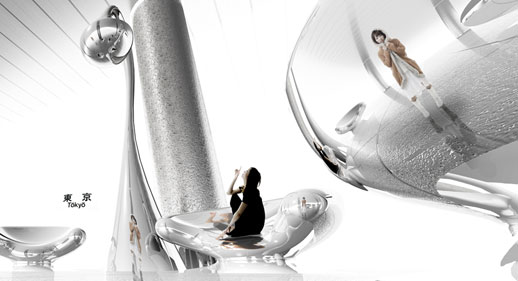
…and what are these “things”?
As part of the installation, Tokyo Reflections is introduced to the public on ‘museum-like’ signs explaining:
“The story goes that before the Tokyo subway system was used as a tunnel system; the underground spaces were inhabited by almost forgotten alien species. This ancient species was divided into two groups: the inter-actor and the observers. ‘Tokyo Reflections’ is a temporary interactive installation in Tokyo Station, Japan and other stations across the network, where the public is able to experience typical behaviors of this nearly forgotten species. One can participate as an inter-actor in an open communicative way, encouraging gatherings in small groups. On the other hand, one can take the place of the observer which simply stands around the inter-actors, documenting rather than participating, viewing everything from the underside of their eyes. It is believed that these species failed to reproduce when their genetic codes are mixed with the human species as their observing genes are too dominant. The theory still awaits scientific proof.”
What was your inspiration for this?
In Japanese literature, art and movies, the search for meaning and reason of existence is omnipresent. Particularly in pop and youth culture, such as anime, manga, TV-series and music, self-reflection and the definition of “I” often play the key roles. Normality, common rules and daily routine often play the counterpart, the enemy of self-awareness.
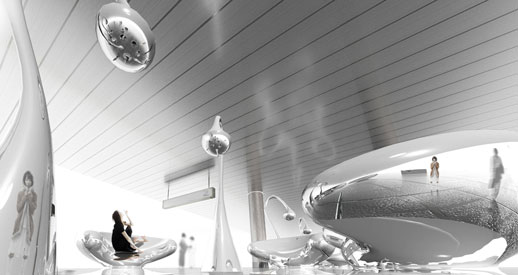
Taking this thought to its limits, fictionally, Tokyo experienced more destructions, alien invasions and apocalyptic scenarios than any other city in the world. The sudden change of circumstances, often life- and existence-threatening, where individuals are forced to redefine the notion of existence, confronting the mind in the state of unawareness through an encounter of unexpected nature.
Additionally, in contrary to other cities around the world, public spaces in Tokyo are not depended upon individuals’ performing as protagonists, just as Donald Richie describes in “A view on the city” – the individuals are active observers. By taking part in ‘Tokyo Reflections’, by being present, by occupying these ‘things’, possibly reflecting, communicating or simply observing, individuals become a part of the reflections.
No matter how active or inactive your role is, you become a part of the entire scenario and this scenario is what makes you aware of your role: “Who you are” and “Where you are”.
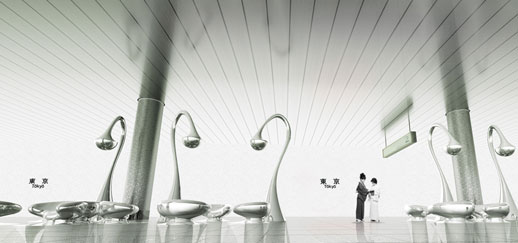
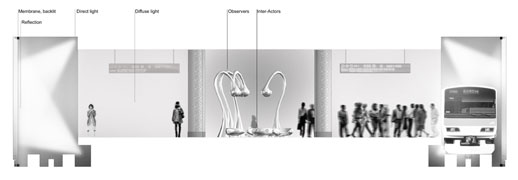
Tell us something about your ‘role’ – who are you and where do you work?
Cheungvogl is a partnership between Chinese-Canadian architect Judy Cheung and German architect Christoph Vogl. The practice was founded in Hong Kong in 2008/2009, currently working on varies scale projects in Europe, North America and Japan.
We see architecture as more than building an end product. Therefore our practice is not bounded within a defined rigid office structure. It is a living structure that adapts to a continual evolving state. Our approach to architecture, understood as the structure of anything, is maybe best described using the parable of the singing bird in an open cage…
Now we all want to know: When is ‘Tokyo Reflections’ going to happen?
Tokyo Reflections is planned to take its origin in Tokyo Station, the place where we first discovered the existence of the alien gene, affecting human communication and sense of awareness. From there on, the installation is meant to find its way through the underground system to other, more remote located platforms. On its way of exploration and discovery –- sometimes as a group, sometimes as separated individuals –- the journey will take the alien travelers over ground, for example in front of Shinjuku Station, Shibuya crossing and Shinjuku Gardens.
In the end, the stay of our alien (so familiar) reflections depends on the willingness, sponsorship and hospitality of the hosts.
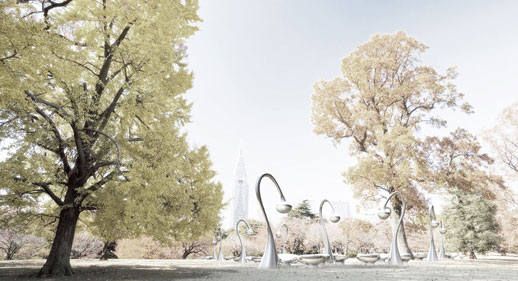
Visit to the cheungvogl website for more information and images of the project.
Fritz Schumann
Fritz Schumann



